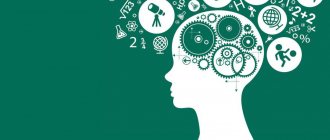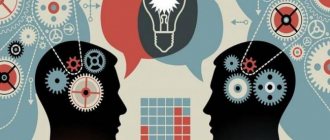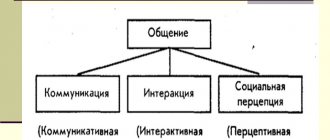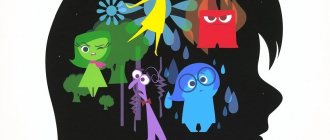Motor skill - automated influence on an external object with the help of movements in order to transform it, which has been repeatedly carried out previously.
Intellectual skill - automated techniques, ways to solve previously encountered mental problems.
Perceptual skill - automated sensory reflections of the properties and characteristics of well-known objects that have been repeatedly perceived before.
There are two fundamentally different types of skills: skills as primarily automatic actions, which involuntarily develop on the basis of instinctive motivation as a result of an unintentional combination of circumstances, and skills that are consciously developed in the learning process through deliberate reinforcement or automation of initially non-automatic actions.
The mechanism of primary automatic skills is conditioned reflexes; they are formed through the mechanism of temporary connections. Skills of the second type, secondarily automated actions, require, in addition to the mechanism of conditioned reflexes that is essential for their consolidation, also other “mechanisms” of an intellectual order - more or less generalized semantic connections.
The difference between these two types of skill is not only quantitative, but also qualitative, significant, fundamental. Skills of the second type are available only to humans (although humans have not only such consciously developed skills, but also involuntarily developed ones). The development of skills of the second type required fundamental general shifts in development: the transition from biological to historical development and the associated emergence of intellectual forms of cognition and conscious forms of behavior characteristic of humans.
Therefore, understanding and intelligence are involved in learning, and behaviorists have narrowed the range of memory phenomena to skills, and reduced learning to mechanical repetition and memorization, and in this they are WRONG.
Understanding or Intelligence
(from Latin intellectus - understanding, cognition) is an ability that unites all the cognitive abilities of an individual: sensation, perception, memory, representation, thinking, imagination/
Intelligence (from Latin intellectus - understanding, cognition) is the ability to carry out the process of cognition and to effectively solve problems, in particular when mastering a new range of life tasks.
2. Characteristics of skills and abilities.
Norman. Skill Stats:
1. Smoothness, ease of activity (for example, a professional solves a problem with apparent ease).
2. Automation. Disconnection of higher levels of consciousness (good typists do not know which finger in which situation they press the spacebar).
3. Mental effort decreases among professionals (Kahneman: correlation with pupil dilation).
4. The impact of stress is less among professionals. Since actions are automated and less mental effort is spent on them, stress does not arise.
5. Interpretation of the problem. Airplane, car, etc. for experienced professionals it is only a tool (“the pilot does not control the plane, but flies”).
The beauty of performing an activity. All these characteristics are harmoniously interconnected.
3. Learning and understanding. Norman.
▫ Learning without understanding: “learned idiots” can raise colossal numbers to powers, but they can’t do anything else.
▫ Understanding (or knowledge) without teaching: a strict instruction is given, it is understood normally, but under certain conditions it is still not followed (scuba divers do not dump ballast and drown, pilots do not lower their landing gear and crash).
4. Learning curve. — graphical representation of the learning process. It is assumed that its typical shape is a curve reflecting negative acceleration. This question remains unclear because there are so many variables that influence the course of learning that it is impossible to make any reliable generalizations.
Thorndike initially used the learning curve in his experiments. The progress of the experiments and the results were depicted graphically in the form of curves, where repeated samples were marked on the abscissa axis, and the time spent (in minutes) was marked on the ordinate axis.
Learning curve:
· falls if the measure is errors (i.e. if there are errors along the y axis and minutes along the ox axis, then since there will be fewer and fewer of them with the passage of time, the curve falls)
· increases if the measure is the number of actions per unit of time (the better we learn to do something, the faster we do it)
To obtain a complete learning curve, one must begin at the stage where the exercise is missing and continue until the subject exhausts himself.
The slope characterizes the speed of improvement (if fast - straight; usually - teeth). Horizontal sections of the curve:
1) Starting area. The subject's score at the very beginning was approximately zero. Example: juggling balls; Pavlov: A dog does not produce saliva immediately.
2) The final platform, a) good level (motivational limit); b) physiological limit.
3) Intermediate platform (plateau).
Perceptual skills
are automated mechanisms for perception, identification and classification of various information (stimuli, signals, irritants, situations, etc.).
Perceptual skills are mastered as if by themselves and are necessary, for example, for recognizing and distinguishing commands. At the very beginning of the training process, the puppy may confuse the execution of techniques and sit down on the “lie down” command, but over time this goes away. The dog learns to quickly and correctly recognize the signal command.
An example of the formation of a perceptual skill can also be a decrease in the indicative reaction during negative learning.
Under intellectual skills
imply automated algorithms, techniques and methods for solving problems that animals face in the process of life.
We can observe this behavior only when the dog is very interested and wants to think: during a hunt, when he wants to deceive us: not follow a command, steal something from the table, climb into the refrigerator, etc.
Motor or motor skills
– these are mastered and strengthened actions that provide optimal solutions to a motor task.
Motor skills not only include perceptual and intellectual skills, but are also regulated by them.
Under a high degree of mastery of action
imply its reliability, high speed of implementation, uniformity of reproducible elements of the action, independence of the action from external influence and the absence of conscious element-by-element regulation and control.
Ability and skill differ from each other in the degree of mastery of an action.
Under motor skill
refers to a relatively stable, but unstable to the action of disruptive factors (the appearance of a cat, a running person, etc.) degree of mastery of motor actions, which is characterized by conscious control of the elements of movement.
A skill is not reducible to a conditioned reflex, and it cannot be compared with a chain or set of conditioned reflexes. Any completed behavior of an animal (behavioral act) is much more complex and represents a set of inherited and acquired elements of behavior, the interaction of which occurs under the control and control of the animal’s intellectual apparatus.
The speed of skill formation is influenced by the animal’s ability to master the intended action, the type and level of motivation and the underlying need, the animal’s experience, the method of forming the action, the training regimen and the characteristics of reinforcement.
Stanley Coren
ranked dogs by intelligence level.
Published the book “The Intelligence of Dogs”
. It was not published in Russian.
Stanley Coren, How to Talk to a Dog.
E.N. Chukharev
- second general of cynology. He was a good organizer in the field of cynology. The first general was Medvedev.
The ability to learn in a breed is individual, because there is no selection for this quality.
The individual characteristics of a dog are expressed, first of all, in the psychophysiological properties of the animal: motivational-emotional characteristics (indifference), reactivity (ability to react quickly), excitability, lability of the central nervous system (quick transition from excitement to calmness and vice versa) - which have a significant impact on the ability to learning.
The theme of the relationship between teacher and student has ancient roots. Philosophers' thoughts on this topic are given in brief aphorisms: “when the student is ready, the teacher appears” and “the teaching about people is short, but knowledge is long.” Both statements imply a willingness to fully perceive the teacher or people (accurate interpretation of nonverbal communication). The development of perceptual abilities occurs according to a certain scenario. Taking them into account, as a rule, helps in many life situations to find relationships with others, and in cases of professional activity of specialists whose sphere of influence lies in the “person-to-person” area, it increases competence and success.
Meaning of the term
The word "perception" (percipere) of Latin origin literally translates as "perception". It has been known since Antiquity, but the issue of the development of perceptual abilities is being developed in detail by modern psychology. This fact does not mean that the study of the issue of completeness of perception was carried out fragmentarily. The problem of developing the perceptive abilities of an individual gained particular popularity thanks to Gottfried Leibniz. He meant by the term "perception" "vague impressions" as opposed to apperception - clear awareness of perception.
In modern psychology, perception appears along with such abilities as thinking, memory, attention, and has such properties as:
- objectivity;
- apperception;
- contextuality;
- meaningfulness;
- structure.
The scientific study of perception is carried out using empirical methods and modeling.
A few words about role principles of behavior
Separately, it is worth mentioning the role principles of behavior. Thus, the role principle of perceptivity is that a person’s role should be positively perceived by his interlocutors, and he, in turn, should positively perceive their interests.
The principle of interactivity is that the fulfillment of a certain role by a person in society should simplify the regulation of the behavior of his interlocutors by influencing his goals and motives. Just like the role principle of perceptivity, it implies that the interests of the interlocutor must be taken into account.
Skill formation and development opportunities
All skills are formed in infancy and develop throughout almost a person’s life. Perceptual abilities are no exception. This is the most favorable period of a person’s life for the development of almost all abilities. Development occurs taking into account the characteristics of the individual development of the child.
In the period from 2 to 6 years, sensory-perceptual abilities are formed and developed. This state of affairs is due to the physiological development and improvement of the functioning of receptors. Based on this, two classifications of perceptual abilities have been adopted. This is perception by modality (visual, auditory, kinesthetic), as well as by the form of matter (space, movement, time).
Based on how these (and other) skills are formed by the age of seven, psychologists make a conclusion about readiness for learning. Sensory-perceptual abilities are basic, on the foundation of which more complex formations then appear (social-perceptual and perceptual-reflexive abilities). This happens mainly after the child identifies himself as an individual and begins to try on different social roles.
It should be noted that if for some organic reasons the process of formation of basic abilities is distorted (due to visual impairment, hearing, motor-skeletal system, other diseases), then more complex types may either not appear or appear in a distorted form. With normal development, perceptual-reflexive abilities, like others, can be developed and improved throughout life.
How to improve perceptual thinking in children?
Correspondence
The best way to improve your child's visual recognition abilities is to practice matching games. There are many ways to practice matching with your child.
You can try matching colors first. This means that you can simply ask your child to, for example, find all the white things in the room.
We also recommend reading: Amazing optical illusions
Additionally, your child can practice matching sizes and shapes. An interesting game is also matching pictures with matching words. You can also ask your child to find an object that starts with a specific letter.
It is also recommended that your child play memory games. Because they develop not only matching but also your child's memory skills. The child can play these games using cards with symbols. In these games, the child will need to connect two matching cards.
Tell the Difference
There are many activities that can help children develop their ability to recognize differences. It is very important for children to know what this or that object belongs to. This is one of the most important parts of perceptual thinking.
You can give your child two pictures that are almost the same, but there are slight differences between them. You can find these pictures in magazines.
Another way to practice this skill with your child is to ask him to find an object that does not belong to a group. For example, you can give your child the following items: milk, cheese, yogurt and a pencil. Of course, your child will identify the pencil as an object that does not belong to the group. You can find some more complex examples later.
Visual memory
It is very important for your child to develop visual memory. First you need to show your child a certain picture, and then close part of this picture. Ask your child to describe what he saw. Later, you can ask your child to describe the image in detail and also to compare the image with other images.
Left and right orientation
This orientation is a very important part of visual perception. First you need to explain to children the difference between right and left. Ask your child to hold something in his left hand or point in a certain direction.
We also recommend reading: What is a profession
Puzzles
Puzzles are a great way for your child to practice their visual perception skills. They will need to rotate the pictures and match the shapes. These skills are believed to be essential for good grades in mathematics.
Depth perception
This type of perception is also very important for children. This is also another segment of perceptual thinking. For example, you can put several items in a box and ask your child to pick up the items that are on the top of the box.
Math skills
Mathematical skills are also a very important part of perceptual thinking. Children can begin to practice these skills by matching numbers related items. For example, four apples, three rabbits...
Teach children to concentrate.
It is very important that children learn to concentrate. They should learn to concentrate on a specific idea or a specific task. You must help your child develop concentration skills. It is important to minimize any distractions such as TV, noise, other people...
Logical thinking
It is also very important to stimulate your child's logical thinking skills. Logical thinking is also part of perceptual thinking. For example, you can ask your child what will happen next and why it will happen. It is important to ask children to answer your questions in more detail than “yes” or “no.”
Development programs and methods
All programs and methods for developing perceptual abilities are divided into three groups:
- complexes for children (and adults) with developmental problems;
- for children (and adults) with normal development;
- for the gifted.
They take into account not only intellectual, but also age and gender characteristics of the development of children, adolescents and adults. To determine the appropriate option, you need to read the explanatory note. It describes in detail the target audience, goals and objectives of the methodology or program.
Teenagers
With age, the role of accuracy and complexity of perception only increases, and the structure becomes more complex. Therefore, the leading activity of adolescents is not learning, but communication (a treasure trove for the development of perceptual abilities). Ignoring the importance of communication for teenagers by adults is unacceptable. This is the period of painstaking cutting of the “diamond” called “communication”. Thus, the teenager gets to know himself, takes an “inventory” of the inner world and completes the formation of the “I-concept”.
Social significance of the skill
A person gets to know himself, the people around him and the world through communication (verbal and non-verbal). On this basis, the socio-perceptual abilities of the individual are formed and developed. Understanding of the emotional experiences of the interlocutor is formed in preschoolers in the process of communication with significant adults and peers. This necessary component of communication is formed gradually, unconsciously, as an adaptation to the surrounding reality.
Communication is a process consisting of social perception, interaction (exchange of actions) and communication. The exclusion of any component leads to misunderstanding, misinterpretation of intentions, and distortion of contact between interlocutors. If adults consciously work on communication (exchange of information) and interaction almost all their lives, then with perception things are more complicated.
The formation and development of social-perceptual abilities is influenced by the child’s experience of family situations and associated emotional states. At the same time, the emotions shown by both parents have a great influence on the child. As a rule, the wider the children, the more successfully they recognize the emotional state of their interlocutor.
If it so happens that an adult’s perceptual abilities are not formed at an insufficient level and this fact is a significant obstacle to establishing and maintaining contacts, then a lot of time and effort will have to be devoted to eliminating the problem. At the moment, special computer programs have been created to help correct the perception of the interlocutor’s emotions based on facial expressions (more precisely, facial microexpressions).
The problems of interpreting a person’s emotional states are described in his books by a famous psychologist. Since the occurrence of such a problem can significantly ruin a person’s life, special courses on teaching communication, methods, lists of recommendations and exercises are being created.
Perceptual teaching skills that help ensure lesson success. Related article
"Perceptual teaching abilities
helping to ensure the success of the lesson"
Practical pedagogical activity is only half built on rational technology. The other half of it is art. Pedagogical abilities are a personality quality. The main groups of abilities are distinguished:
* Organizational - the teacher’s ability to unite students, keep them busy, divide responsibilities, plan work, sum up.
* Didactic - skills to select and prepare educational material, clarity, equipment; present educational material in an accessible, clear and consistent manner; stimulate the development of cognitive interests.
*Perceptual - the ability to penetrate into the spiritual world of those being educated, objectively assess their emotional state, and identify mental characteristics.
*Suggestive abilities consist of an emotional-volitional influence on students.
*Research - the ability to understand and objectively evaluate pedagogical situations.
* Scientific-cognitive - the ability to assimilate new scientific knowledge in the chosen field.
Are all abilities equally important in the practical activities of a teacher? It turns out not. Leading abilities are:
*pedagogical vigilance
*didactic
*organizational.
The remaining abilities can be classified as auxiliary, accompanying. Let us dwell on one group of pedagogical abilities - perceptual abilities - the ability to identify the characteristics of the student’s psyche.
Some theorists suggest that human behavior, both normal and abnormal, is influenced by:
1.family environment
2.society
3.culture.
We are all part of the social framework of family, friends, acquaintances and even strangers; Some types of relationships with others in which we are involved can reinforce deviations in behavior and even cause them to arise.
Pedagogical activity is a specific activity, and its main feature is that the main subject of work here is the personality of another person. At the center of this activity is the emerging personality. Therefore, this person is especially sensitive to various social influences, especially vulnerable and less stable.
Obtaining adequate knowledge about the student’s personality is also important from another point of view. Studying the student’s personality seems necessary as a condition and method for providing feedback in the pedagogical process.
Psychodiagnostics of personality can help a teacher in solving most pedagogical problems. There is a whole package of tests that determine a person’s character type. The concept of “accentuation” was first introduced by the German psychiatrist and psychologist Leonhard. In our country, a different classification of accentuations has become widespread, which was proposed by the famous child psychiatrist, Professor Andrei Evgenievich Lichko.
Hyperthymic type.
High spirits, a thirst for novelty in everything - this determines all behavior. The most important feature of hyperthymic individuals is their great mobility, activity, tendency to mischief, restlessness, sociability, and talkativeness. All this manifests itself in the educational process in the form of restlessness and indiscipline. This behavior of hyperthyms very often causes displeasure and a sharp reaction from teachers.
The first signs of this type are already visible in elementary school. A high degree of activity is combined with a constant desire for leadership. Great activity is combined with promiscuity in choosing acquaintances. They easily adapt to unfamiliar surroundings, but do not tolerate loneliness, strict discipline, monotonous work requiring minute precision, and forced idleness. They tend to overestimate their capabilities and overly optimistic plans for the future. The desire of others to suppress their activity often leads to violent but short outbursts of irritation.
Particular attention should be paid to maintaining a distance sufficient for productive interaction. You can’t use cruelty, you need to interest (throw up new ideas)
Cycloid type.
It is characterized by a constant change of mood, independent of the person himself or the circumstances. The mood alternates between periods of mild depression and periods of hyperactivity for 10-15 days. This character type is three times more common in girls than in boys. In the subdepressive phase, performance decreases, interest in everything is lost, the teenager becomes a homebody and avoids company. Failures and even minor troubles are difficult to experience. Serious complaints, especially those that humiliate self-esteem, can lead to thoughts of one’s own inferiority and uselessness. Between phases there is often a fairly long period of “harmonious” behavior. The first signs of this type are around 12 years of age.
Recommendations for teachers: monitor mood, reduce demands during periods of depression.
Emotionally labile type.
The leading radical of this type is emotional lability. Changes in mood are frequent, but are associated with minor external stimuli and various life situations. Doesn't pretend to be a leader. He prefers to be around people who treat him well and are amorous. Labile adolescents have sincere and deep feelings and affections, especially for those individuals who themselves show love, attention and care. There is a great need for empathy. They subtly sense the attitude of others towards them, even with superficial contact. They have a hard time experiencing loss or emotional rejection from significant others.
Recommendations for teachers - praise, encouragement - this improves the mood and stimulates the teenager to activity.
Astheno-neurotic type.
The main features are increased fatigue and irritability. Slow performance, short peak and fast decline. Fatigue usually manifests itself during mental activities and in an environment of competition and rivalry. When tired, affective outbursts arise for insignificant reasons (these outbursts are physiological). They do not claim leadership, are easily subordinated, and are often influenced by others. Begins to appear at 9-11 years of age. Present throughout life. Regardless of their level of intelligence, they study averagely.
Recommendations for teachers: reduce the level of requirements (inflate grades), ask at 20-25 minutes of the lesson.
Psychasthenic type.
The main features are indecision, anxious suspiciousness (in the form of fears for the future of oneself and one’s loved ones) and a tendency to introspection. Character traits are revealed already in elementary school. Taking responsibility for yourself, and especially for others, can be the most difficult task. The type is consolidated at the age of 12-14 years, before this it is easy for doubts to arise. He does not pretend to be a leader, does not fall under influence, communicates among his own kind. Tend to study something in depth, independent, indecisive. They have correct self-esteem.
Recommendations for teachers: do not put them in a position of choice (you cannot teach), give only specific tasks. Use the penchant for deep learning, make it a think tank - let him study something and tell others.
Sensitive type.
Defined by timidity, vulnerability, indecision. Has a high level of demands on himself. Appears at 10-12-13 years, some signs even earlier. They are selective in communication, if they have become friends, they are loyal to their friendship, they are attached to loved ones, to their parents. They see many shortcomings in themselves, especially in the area of strong-willed qualities. Dissatisfaction with one's physical self (“body image”) is common. Reticence, timidity and shyness are especially evident among strangers and in unfamiliar surroundings. Even the most superficial contacts with strangers are difficult, but with those to whom they are accustomed, they are quite sociable. Extreme difficulties are caused by situations of negative evaluation or blame. Responsible, they study regardless of their level of intelligence, good. They prefer to live in illusions, in castles in the air. Sensitive people have a hard time with their parents' divorce. Considered as a betrayal.
Recommendations for teachers: You should not abruptly tear yourself out of your usual environment, even if you are going to go to college, it is advisable that your mother also go. An individual approach is required. You have to be sincere with the sensitive type. The most difficult type.
Schizoid type.
The main features are isolation and lack of sensitivity in the communication process, inability and reluctance to communicate, inability to understand other people's experiences, desires and thoughts of the partner. He doesn't care much about what's around him. Often sloppy, natural behavior is to read in a noisy, cheerful company. They formulate their conclusions in a complex, abstruse way, do not feel the pain of others and do not demand attention to themselves. They have weird hobbies. Character traits appear at 10-12 years of age.
Recommendations for teachers: you should leave the person alone (since the schizoid is self-sufficient) or become interested in him (which can be difficult)
Epileptoid type.
The main feature is a tendency to states of angry-melancholy mood, with constantly increasing irritation and a search for an object on which to take out evil. Characterized by affective explosiveness. These explosions are not only strong, but also long lasting. Love is almost always tinged with jealousy. An insatiable desire for leadership, they allow for a hierarchy of power, they achieve power by any means. They adapt well to conditions of a strict disciplinary regime, where through ostentatious performance in front of their superiors they strive to gain a position that gives them power over other teenagers. Characterized by meticulousness and strict adherence to rules (sometimes to the detriment of business)
Recommendations for teachers - you can give power, but delegate it in such a way that you can take it away (i.e. give little, otherwise you won’t take it away).
Hysterical type.
The desire to stand out, to be bright, the thirst for attention to oneself. The first signs appear quite early, even in kindergarten. They study better than anyone else or worst of everyone. There may be deceitful, unusual hobbies (no one else has this). A tendency towards posing, characterized by theatricality of experiences. A low ability to work hard is combined with high aspirations for a future profession. Among their peers they claim primacy or an exceptional position.
Recommendations for teachers - the more attention is paid to them, the more they want. Therefore, tasks with any creative options are needed. There are many hysterical actors among the actors.
Unstable type.
An irrepressible thirst for pleasure with an unwillingness to work, superficiality of hobbies. Signs of this type are already visible at 8-10 years of age. They study poorly and play truant. They easily obey and are influenced by the epileptoid type. Alcoholism quickly appears at 15-16 years of age (with early alcoholism). Under strict and continuous control, they reluctantly obey, but always look for an opportunity to shirk any work. Weak volitional component of personality. They are indifferent to their future, do not make plans, live in the present. Neglect quickly has a detrimental effect.
Recommendations for teachers: strict regulation of time for completing tasks, a “tight-knuckle” regime.
Conformal type.
The main feature is conformity: a pronounced desire to be “like everyone else.” This desire extends to everything - from the desire to dress like everyone else, to a strong dependence on the environment, judgments, attitudes and behavior. In a “good” environment they study well, try and work; in a “bad” environment they quickly learn its customs, habits, and behavior. They work most successfully when personal initiative is not required.
Recommendations for teachers: help change companies.
Summarizing all that has been said, we can obviously conclude that accentuation is not a pathology, but an extreme variant of the norm.
Used Books:
1. Podlasy I.P.” Pedagogy”, textbook part 1.
2. Rean A.A. "Psychology of personality studies."
3. Rean A.A. "Practical psychodiagnostics of personality."
4. Kjell A., Ziegler D. “Theories of Personality.”
Who needs to develop perceptual abilities and why?
People working in the service sector, education, and logistics communicate with clients, colleagues, students, and consumers every day. In their professional activities, developed perceptual abilities are the key to the successful implementation of goals and objectives. And not only on the professional path.
The developed perception of the interlocutor’s state also plays a huge role at the interpersonal level of communication. Often educated and intelligent people, who are unable to “read” a person on their own, suffer from distrust and suspicion of others, which interferes with their self-realization and pushes them to erroneous actions and conclusions. After all, a person gets to know himself through communication with other people. If communication is distorted, then the image of “I” undergoes corresponding changes.
It is important for every person to have a developed perception of an interlocutor, but the mechanisms and principles for using this ability will vary among all representatives of society.
What is the perceptual side of communication?
The perceptual side of communication (from the Latin perceptio - perception) is a special process that manifests itself in the course of interaction between individuals on the basis of natural communication, thanks to which participants in communication can correctly perceive each other’s actions and actions. In simple terms, within the framework of the perceptual side of communication, people “read” each other, which allows them to receive much more information and go beyond a simple verbal exchange.
Perception characterizes the perception of one person by another, when participants in communication have the opportunity to form an idea of themselves and their interlocutor. This became possible thanks to an understanding of goals and motives, which is no less important than the words spoken out loud. Within the framework of a dialogue, a person carries out an objective assessment of the interlocutor, whose internal qualities may not correspond to his own qualities. This format allows people to understand each other and identify opportunities and prospects for communication based on the coincidence of interests, views and worldview.
In psychology, perception is considered as a person’s ability to display at a cognitive level the objects of the surrounding world that he encounters throughout his life. Among the manifestations of perception are understanding and acceptance. This feature allows people to find a common language and build strong communication.
Parents
Perceptual pedagogical abilities are the perception and understanding of the state of the interlocutor without relying on verbal information (words). Consequently, every parent who worries about their children has this ability to one degree or another. There is a directly proportional relationship between “trusting” communication with a child and the formation of pedagogical perception in adults.
During early childhood, it is mom and dad who copy. Therefore, you can often hear the saying that children are a mirror of family relationships. Until the age of three, children unconsciously repeat gestures, words, intonations, and facial expressions after significant adults. Keeping this in mind, parents can fully demonstrate their pedagogical abilities in communicating with their child.
Perception in psychology
Perception in psychology is a person’s attitude to the world, which is formed under the influence of information received from the outside through the main sense organs. Translated from Latin, this word means “perception.” The opposite concept is apperception. A person needs to perceive the world correctly, because perception:
- helps to develop the right attitude towards people;
- promotes activation of cognitive function of the brain;
- promotes effective communication;
- makes it possible to correctly evaluate yourself and those around you.
This concept is one of the most studied in theoretical and practical psychology. Perception skills are formed from early childhood, so parents should give their child as much information as possible that can be learned through the senses. This could be music and various sounds, beautiful images, toys for the development of tactile skills.
Educators
In kindergarten, children gain experience communicating with peers and adults, who are sometimes ahead of their parents in importance. The team of the kindergarten group and parents is a fertile environment for the use of the teacher’s perceptual abilities.
The success of his professional activity directly depends on the ability to perceive in detail the state of his interlocutor and adequately interpret behavior and intentions. After all, raising a child occurs through direct communication with the teacher: in this case there are no secondary things, everything is important - facial expressions, intonation, gestures, diction, the distance between the interlocutors, the teacher’s competence in the issue under discussion, his personal position in relation to reality. After all, only the Personality (through full communication) educates the Personality.
The perceptual abilities of a teacher are the ability to perceive the student “whole”: with behavioral advantages and disadvantages, features of the development of the psychomotor sphere, communication and existing social experience of communication. The ability to “separate the wheat from the chaff,” nurture them and guide them along the path of harmonious development can be considered the talent of an educator who influences children by personal example purposefully and indirectly.
Gender characteristics of perception
There are more perceptive personalities among women than among men. Therefore, women are more successful in teaching. This feature must be kept in mind when creating a favorable psychological climate in the team. Men, compared to women, have better developed tactile perception of the world and cognition through tactile experience.
Interesting. In Russia there is a saying that a woman loves with her ears, and a man loves with her eyes. This, in a nutshell, means that representatives of the stronger sex perceive verbal information (for example, compliments) best, while gentlemen are typical visual learners.
It is known that internal perception, useful in interpersonal relationships, as well as intuition, can be developed with the help of special training and spiritual practices, as well as a teacher-psychologist. During some psychological exercises, especially at a young or childhood age, for example, in preschoolers, the main senses begin to perceive the world around them more acutely. At such moments of learning, perception becomes the leading source of knowledge.
InterpretationTranslationPerceptual activity
Human psychology from birth to death. — SPb.: PRIME-EUROZNAK. Under the general editorship of A.A. Reana. 2002.
See what “Perceptual activity” is in other dictionaries:
- perception is a holistic reflection of objects, situations and events that arises from the direct impact of physical stimuli on the receptor surfaces (see receptor) of the sense organs. Together with the processes of sensation... Great Psychological Encyclopedia
- perception - PERCEPTION is a form of sensory cognition that subjectively appears to be immediate and relates to objects (physical things, living beings, people) and objective situations (the relationships of objects, movements, events). For... ... Encyclopedia of Epistemology and Philosophy of Science
- Interpersonal cognition: methods - Skills, abilities and methods of interpersonal cognition (IK) have been studied for a long time as cognitive structural formations. So, in the 1940s. J. Bruner proposed the concept of perception, the central place in which is occupied by the concept ... ... Psychology of communication. encyclopedic Dictionary
- Perception - - 1) a subjective image of an object, phenomenon or process that directly affects the analyzer or system of analyzers (the terms “image of perception”, “perceptual image” are also used); 2) the process of forming this image... ... Dictionary-reference book for social work
- Perception is the ability to synthesize visual images from individual sensations (A.N. Leontiev). The process of perception itself presumably proceeds in several stages and with the participation of such processes. The latter are: 1. focusing on the sensory... ... Encyclopedic Dictionary of Psychology and Pedagogy
- Perception - (from Latin perceptio perception), the process of direct active reflection by the cognitive sphere of a person of external and internal objects (objects), situations, events, phenomena, etc. * * * (Latin perceptio - perception) - perception (as opposed to ... ... Encyclopedic Dictionary of Psychology and Pedagogy
- PSYCHOLOGICAL FOUNDATIONS OF THE METHOD - abstraction, automation, automatism, agrammatism, adaptation, sensory adaptation, social adaptation, adaptability, adequacy of perception, adequacy of sensations, acculturation, acmeology, acceleration, act of activity, activation,... ... New dictionary of methodological terms and concepts (theory and language teaching practice)
- PERCEPTION is a continuous sequence of internal figurative representations that arise in the cognitive system of living beings, reproducing sensory recognizable objects, events, states, etc. Initially, human knowledge is of a sensual nature.… … Philosophical Encyclopedia
- communication is a complex, multifaceted process of establishing and developing contacts between people (interpersonal communication) and groups (intergroup communication), generated by the needs of joint activities and including at least three different processes: communication... ... Great Psychological Encyclopedia
- REPRESENTATION - an image of an earlier perceived object or phenomenon (P. memory, recollection), as well as an image created by the productive imagination; form of feelings. reflection in the form of visual knowledge. In contrast to perception, P. rises above the immediate means... Philosophical Encyclopedia
Interpretation: Perceptual actions are structural units of the human perception process.
P. d. provide the conscious selection of one or another aspect of a sensory given situation, as well as the transformation of sensory information, leading to the construction of an image adequate to the objective world and the tasks of activity. Brief psychological dictionary. — Rostov-on-Don: “PHOENIX”. L.A. Karpenko, A.V. Petrovsky, M. G. Yaroshevsky. 1998.
perceptual actions
Etymology. Comes from Lat. pertertio - perception. Category. The main structural units of the perception process, ensuring the construction of an object image. Specificity. They are implemented using various sets of perceptual operations.
Psychological Dictionary. THEM. Kondakov. 2000.
PERCEPTUAL ACTIONS are the basic structural units of the human perception process.
P. d. are associated with the conscious identification of one or another aspect of a sensory given situation, as well as various kinds of transformations of sensory information, leading to the creation of an image adequate to the tasks of the activity and the objective world. The concept of P. d. was first put forward by A. V. Zaporozhets, in whose school they were most fully studied (see Theory of the development of perception through the formation of perceptual actions). Currently, the understanding of perception as a system of physical activity is widespread in Russian psychology. Close to it are the statements of such prominent foreign psychologists as J. Piaget, J. Gibson, R. Held, W. Neisser. Studies of the ontogenetic (see Ontogenesis) development of perception processes show that at first they are included in the external practical actions of the child. As the activity becomes more complex and the demands it places on the objective reflection of the situation, the process itself is distinguished, carried out in terms of a sensory image. The genetic connection of physical activity with practical actions is manifested in their extensive, external motor nature. In the movements of the hand, feeling an object (see Touch), in the movements of the eyes, tracing the visible contour, in the movements of the larynx, reproducing an audible sound, there is a continuous comparison of the image with the original, its verification and correction is carried out. Further development of activity is accompanied by a significant reduction in the motor components of P etc., as a result of which the process of perception externally takes the form of a one-time (simultaneous) act of “discretion.” These changes are determined by the development in the child of a whole system of operational units of perception and sensory standards that mediate perception and transform it from a process of image construction into a more elementary process of recognition. It is important to note that sensory standards correspond to such socially developed systems of sensory qualities as the generally accepted pitch scale of musical sounds, the “grid” of phonemes of the native language, or a system of geometric shapes. Having mastered systems of sensory standards throughout childhood, the child learns to use them as a kind of sensory standards for systematizing the properties of the surrounding reality. Any sensory action can be realized with the help of a significant number of different perceptual operations.
Of great practical importance is the study of the operational and technical side of specific perceptual (observational) types of labor activity of radar station operators, decipherers of traces of elementary particles and aerial photographs. Among them, such functions were identified and studied as signal detection, identification of information features and familiarization with them, identification, recognition (categorization), i.e., assigning a perceived object to a particular class. The process of coordinating various P.D. and their component operations in micro- and macro-intervals of time has been studied relatively little (see Method of microstructural analysis). It also seems relevant to study the semantic relationships that connect P. d. with the activity in the context of which they are carried out. Solving these problems will allow us to get closer to understanding the psychological mechanisms of aesthetic perception and visual thinking. Large psychological dictionary. — M.: Prime-EUROZNAK. Ed. B.G. Meshcheryakova, acad. V.P. Zinchenko. 2003.
Other books on request “perceptual actions” >> —>
Congruence is the correspondence of the client’s experiences with his physiological reaction and the expression of these experiences in the external plane.
Incongruence is a lack of unity in experience, lack of sincerity. The information a person conveys is ambiguous and inaccurate. Causes tension and protection.
Rogers developed client-centered therapy.
The goal of therapy is to eliminate the dissonance between real experience and self-concepts.
Conditions – phenomenological approach. An important concept in therapy is the internal locus of assessment (the personality’s ability to attribute one’s successes or failures to internal factors), which ensures the client’s autonomy. If the internal locus of assessment is formulated, then the leading locus of assessment becomes the motive for personal growth.
The motive of personal growth sets the vector of direction of all the vital forces of the individual. Rogers defines the motive of personal growth as self-realization (self-actualization).
Self-realization is possible with the ability to live in the present, here and now. A person whose self is actualized is able to live here and now. The concept of self denotes an actualized personality striving for self-actualization and integrity.
Rogers believed that therapy based on the phenomenological theory of personality should be instructive. The psychotherapist should not impose his opinion on the patient, but lead him to the right decision, which the patient makes independently. During the therapy process, the patient learns to trust himself more, his intuition, his feelings and impulses. He begins to understand himself better, and then others. As a result, that “illumination” (insight) occurs, which helps to rebuild one’s self-esteem, “restructure the gestalt,” as Rogers said after Wertheimer and Koehler. This increases congruence and enables a person to accept himself and others, improves his communication with them, reduces anxiety and tension.
Rogers's work has had a significant impact on the general understanding of the potential of the human person. He can rightfully be considered one of the founders of the movement for the general humanization of psychology.
In the 80s of the 20th century, the work of C. Rogers “Freedom to Learn” appeared, in which for the first time a person-centered approach to education was psychologically substantiated. K. Rogers, noting the underestimation of the student himself and his activity as one of the shortcomings of the traditional teaching system, proposes to organize teaching itself as activation, facilitation of the learning process.
Three universal conditions (according to C. Rogers) that form a climate that ensures growth and development:
The first element is sincerity or congruence. The more the therapist is himself in relation to the client, the less he is separated from the client by his professional or personal facade, the more likely it is that the client will change and move forward in a constructive way. Authenticity means that the therapist openly experiences the feelings and attitudes that are occurring in the moment. There is a correspondence or congruence between what is experienced at the somatic level, what is presented in consciousness, and what is expressed to the client.
The second most important attitude is acceptance, caring or recognition - an unconditional positive view of the client. When the therapist experiences a positive, nonjudgmental, accepting attitude toward the client regardless of who the client is at the moment, therapeutic progress or change is more likely. The therapist's acceptance involves allowing the client to be in whatever his immediate experience is - confusion, hurt, outrage, fear, anger, courage, love or pride. This is selfless concern. When the therapist acknowledges the client holistically rather than conditionally, progress is more likely.
The third facilitative aspect of relationship is empathic understanding. This means that the therapist accurately perceives the feelings, personal meanings experienced by the client, and communicates this perceived understanding to the client. Ideally, the therapist penetrates so deeply into the inner world of another that he can clarify not only those meanings that he is aware of, but even those that lie just below the level of awareness. This special, active brand of listening is one of the most powerful forces known to bring about change.
InterpretationTranslationperceptual fieldAviation medicine: perceptual field
Universal Russian-English dictionary. Akademik.ru. 2011.
See what a “perceptual field” is in other dictionaries:
- SENSORY FIELD - 1. See perceptual field. 2. See the area of perception... Explanatory Dictionary of Psychology
- BODY - 1) the name of a material extended thing as something objectively physical; 2) inaccurate name of the material carrier of the life of an organism, in particular the human body; 3) the name of a three-dimensional figure in stereometry. Philosophical encyclopedia ... Philosophical encyclopedia
- Perceptual organization - For most psychologists, the topic of perceptual organization serves as a symbol of Gestalt psychology. It was Kurt Koffka who announced to the scientific world that perception is an organized process. Koffka sharply criticized the so-called. “constancy hypothesis” ... ... Psychological Encyclopedia
- BERKELEY - (Berkeley) George (1685 1753) English. philosopher and religious figure, one of the most prominent and consistent representatives of immaterialism in modern times. Since 1734, bishop in Cloyne (Ireland). Main works: “The Experience of a New Theory of Vision” (1709), ... ... Philosophical Encyclopedia
- CONDILLAC - (Condillac) Etienne Bonnodet (1715 1780) the only major French. empiricist philosopher. At the same time, one of the few educators who was engaged in logical research. Brother G.B. de Mably. From 1752 until the end of his life, royal censor. Grandson's teacher... ...Philosophical Encyclopedia
- PHENOMENOLOGY OF PERCEPTION - 'PHENOMENOLOGY OF PERCEPTION' ('Phénoménologie de la perception'. Paris, 1945) is the main work of Merleau Ponty, which explores the problems of the specificity of the existence of existence (see EXISTENCE) and its relationship with the world as 'vital... ... History of Philosophy: Encyclopedia
- PHENOMENOLOGY OF PERCEPTION - (Phenomenologie de la perception. Paris, 1945) the main work of Merleau Ponty, which explores the problems of the specificity of the existence of existence (see Existence) and its relationship with the world as vital communication, as ceaseless and... ... History of Philosophy: Encyclopedia
- Paul VIRILIO (b. 1932) French philosopher, social theorist, urbanist and architectural critic. He studied philosophy at the Sorbonne, was a professional artist in his youth, and was a religious activist in the 1950s. Took part in campaigns... Sociology: Encyclopedia
- Adlerian psychotherapy (adlerian psychotherapy) - The basics of AP were developed by A. Adler at the time when he was part of S. Freud's group. After separating from Freud's circle in 1911, Adler quickly expanded the basics. provisions of his theory and continued to develop it until his death in... ... Psychological Encyclopedia
- Perception (perception) - By perception, or perception, we mean both the subjective experience of receiving sensory information about the world of people, things and events, and those psychological. processes, thanks to Crimea this is accomplished. Classical theory The idea that all of our... ... Psychological Encyclopedia
- GESTALT PSYCHOLOGY - (from German Gestalt structure, image, form, configuration) one of the influential trends in psychology, trans. floor. 20th century Formed under the direct influence of philosophy. phenomenology (E. Husserl), which argued that the perception of the world is... ... Philosophical Encyclopedia
Sources used:
- https://srazu.pro/teoriya/percepciya-v-psixologii.html
- https://psihologiya_cheloveka.academic.ru/268/perceptual_activity
- https://psychology.academic.ru/3799/perceptual_actions
- https://studopedia.ru/10_219653_fenomenalnoe-pertseptivnoe-pole—eto-opit-poluchenniy-individom-v-hode-vsey-zhizni-i-yavlyayushchiysya-unikalnim-dlya-nego-igraet-bolshuyu-rol-v-formirovanii- ya-kontseptsii.html
- https://universal_ru_en.academic.ru/1980153/perceptual_field
Teachers
A teacher's perceptual abilities are the ability to:
- perceive the student’s psychological state;
- keep the whole class and a specific student in sight at the same time;
- differentiate the characteristic features of a student from the manifestation of a momentary state;
- evaluate students’ activities based on the results of completion (positive, negative, neutral), voicing a comprehensive analysis.
It should be noted that the requirements for the skills, abilities and competence of a teacher vary depending on the field of activity: school, college, university. Different researchers classify teacher competencies in different ways. The conclusion about the importance of a person’s pedagogical orientation in activity remains unchanged (at a high level of development of general and special abilities).
Larisa Maksimovna Mitina in her research highlights the reflexive-perceptual abilities of a teacher and their components:
- pedagogical reflection;
- pedagogical tact;
- pedagogical orientation.
All of the above skills are components of pedagogical culture. Its structure includes significant qualities:
- professional and personal;
- professional knowledge;
- professional skills;
- active pedagogical position;
- experience of creative activity.
The value is the child - his development, learning, protection and support of dignity. The developed perceptual abilities of a teacher are the foundation for joint directed activities of teacher and student within the framework of pedagogical culture.
Components of the perceptual side of communication
The perceptual side includes a set of processes, among them the following can be distinguished:
- Assessing non-verbal signals transmitted by the interlocutor;
- Observation of behavioral attitudes;
- Formation, based on the information received, of ideas about the inner world of the interlocutor;
- Formation of the subject’s perception on an emotional level;
- Create effective and lasting communication.
Children of preschool and primary school age
The formation and development of perceptual abilities begins in early childhood. This is due to the child’s adaptation to the world around him and the need for development (which does not exist without communication).
The Mowgli children serve as proof of this. Since they were placed in the environment of wolves, it was possible to survive only by becoming like them (copying their behavior). This “imitation” triggered more complex biological and psychological mechanisms, which ultimately did not allow children to become full-fledged people and shortened their lives to the lifespan of a wolf.
This example makes us think about the significance of the environment (emotional, material, sensory, etc.) in which children find themselves. After all, in childhood, perceptual abilities are the “engine” of a child’s development.
The nature of the perception process
The external environment and its individual objects and phenomena influence the senses through analyzers. Their complex interaction ensures the flow of information into the brain centers and its processing.
Complex analysis and synthesis of external data ensure the creation of a holistic image: external and hidden, internal properties and qualities of the object are determined. That is, a number of its characteristics are formed.
The process of perceiving the same object is unique, as is its mental image, since they depend on the individual mental and physiological characteristics of a person. Life principles, views, motives, interests, preferences as the results of upbringing and lifestyle certainly determine the assessment of the properties and qualities of an object. For example, the same work of art can be emotionally assessed by different observers as “strikingly beautiful” and… “disgusting.”
The role of perceptual abilities in the life of an adult
In the structure of general personality characteristics, perception is closely related to attention, thinking, cognition, sensation and imagination. In everyday life, people with developed perceptual abilities compare favorably with their antipodes. This is expressed in volume, accuracy, completeness and speed of perception, and the emotional coloring of the process. Such people are easy to train, adapt well to the environment, have a creative attitude to work, have their own point of view on current events, and value time.
Perhaps, knowing this pattern, employers, along with professional tests, would also conduct tests for the development of perceptual abilities. Perception also plays an important role in a person’s personal development. The solution to many problems lies in the sphere of completeness and accuracy of perception. That’s why there are sayings “the box just opened” or “it’s hard to find a black cat in a dark room if it’s not there.”
The structure of perceptual action
Any process consists of individual operations - actions. The quality of the result depends on whether they are arranged in the correct sequence and performed without errors.
The process of perception includes a number of perceptual actions, this is due to the fact that a person needs:
- Consciously select information that is significant for him from the multitude that comes through sensory channels.
- Transform it in accordance with your own business objectives.
Perceptual action is several operations to transform sensory information.
Detection—detects the presence of a cognitive stimulus.
Discrimination - a perceptual standard is formed.
Next, the identification process takes place based on such actions as comparison and identification. The received image is compared with the one in memory and belongs to a certain class of objects, that is, it is categorized.
Mastering perceptual actions is a very difficult and lengthy process for a person, requiring special training.
Functions of social perception
There are several main functions that are implemented within the perceptual side of communication:
- Development of mutual understanding. This function acts as a prerequisite for building productive communication between individuals. Having common interests, sharing the same values and beliefs is the foundation for benefiting from communication. It also makes it possible to find compromises in controversial situations;
- Development of emotional interaction. Feelings and emotions are an integral part of relationships. Positive feelings and emotions create sympathy, negative feelings and emotions lead to hostility.
- Formation of ideas about yourself. A participant in communication can obtain information about himself using conclusions obtained during dialogue with other people. As part of interaction with an interlocutor, a person can relay his attitudes and views on himself. As a result, a person can independently identify what was hidden in his consciousness.
- Formation of ideas about the interlocutor. This is manifested in understanding the views and worldview of people from the immediate social environment. In such conditions, a person can form a complete picture of the interlocutor. There are no alternative ways. Communication acts as the fundamental basis for any type of relationship;
- Organization of joint activities. If people entering into communication understand and accept each other, then this helps them conduct joint activities with a focus on quality results. Knowledge about the interlocutor makes it possible to build a strategy for communicating with him in any situation. Perception takes on a new meaning when it comes to communication on the scale of an entire social group. Productive joint activities can only occur if there is complete understanding and acceptance among group members.










